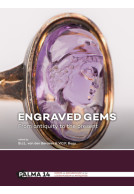Google Books previews are unavailable because you have chosen to turn off third party cookies for enhanced content. Visit our cookies page to review your cookie settings.
Why Leather? (Hardback)
The Material and Cultural Dimensions of Leather
Imprint: Sidestone Press
Pages: 134
Illustrations: 79fc/17bw
ISBN: 9789088904707
Published: 15th December 2017
Script Academic & Professional
Pages: 134
Illustrations: 79fc/17bw
ISBN: 9789088904707
Published: 15th December 2017
Script Academic & Professional
You'll be £100.00 closer to your next £10.00 credit when you purchase Why Leather?. What's this?
+£4.99 UK Delivery or free UK delivery if order is over £40
(click here for international delivery rates)
Need a currency converter? Check XE.com for live rates
(click here for international delivery rates)
Need a currency converter? Check XE.com for live rates
This pioneering volume brings together specialists from contemporary craft and industry and from archaeology to examine both the material properties and the cultural dimensions of leather. The common occurrence of animal skin products through time, whether vegetable tanned leather, parchment, vellum, fat-cured skins or rawhide attest to its enduring versatility, utility and desirability. Typically grouped together as ‘leather’, the versatility of these materials is remarkable: they can be soft and supple like a textile, firm and rigid like a basket, or hard and watertight like a pot or gourd. This volume challenges a simple utilitarian or functional approach to leather; in a world of technological and material choices, leather is appropriated according to its suitability on many levels. In addressing the question Why leather? authors of this volume present new perspectives on the material and cultural dimensions of leather. Their wide-ranging research includes the microscopic examination of skin structure and its influence on behaviour, experiments on medieval cuir bouilli armour, the guild secrets behind the leather components of nineteenth-century industrial machinery, new research on ancient Egyptian chariot leather, the relationship between wine and wineskins, and the making of contemporary leather wall covering.
The Archaeological Leather Group promotes the study of leather and leather objects from archaeological and other contexts. The Group aims to provide a focus for the investigation of leather, and to develop new research by bringing together a broad range of knowledge and experience both practical and academic. Leather is explored through its manufacture, function, context, processing, recording, conservation, care and curation. Members come from a variety of disciplines and include archaeologists, historians, conservators, artefact specialists, materials engineers and leather workers. The Group normally meets twice a year and organises one scholarly meeting in the spring, and visits a museum, working tannery or other place of leather interest in the autumn. The Archaeological Leather Group Newsletter is published twice a year, and the website maintains a comprehensive and expanding leather bibliography.
Other titles in Sidestone Press...















